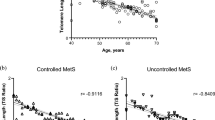Abstract
Telomere length can be considered as a biological marker for cell proliferation and aging. Obesity is associated with adipocyte hypertrophy and proliferation as well as with shorter telomeres in adipose tissue. As adipose tissue is a mixture of different cell types and the cellular composition of adipose tissue changes with obesity, it is unclear what determines telomere length of whole adipose tissue. We aimed to investigate telomere length in whole adipose tissue and isolated adipocytes in relation to adiposity, adipocyte hypertrophy and adipose tissue inflammation and fibrosis. Telomere length was measured by real-time PCR in visceral adipose tissue, and isolated adipocytes of 21 obese women with a waist ranging from 110 to 147 cm and age from 31 to 61 years. Telomere length in adipocytes was shorter than in whole adipose tissue. Telomere length of adipocytes but not whole adipose tissue correlated negatively with waist and adipocyte size, which was still significant after correction for age. Telomere length of whole adipose tissue associated negatively with fibrosis as determined by collagen content. Thus, in extremely obese individuals, adipocyte telomere length is a marker of adiposity, whereas whole adipose tissue telomere length reflects the extent of fibrosis and may indicate adipose tissue dysfunction.
This is a preview of subscription content, access via your institution
Access options
Subscribe to this journal
Receive 12 print issues and online access
$259.00 per year
only $21.58 per issue
Buy this article
- Purchase on Springer Link
- Instant access to full article PDF
Prices may be subject to local taxes which are calculated during checkout


Similar content being viewed by others
References
Jacobs JJ . Loss of telomere protection: consequences and opportunities. Front Oncol 2013; 3: 88.
Ginter E, Simko V . Type 2 diabetes mellitus, pandemic in 21st century. Adv Exp Med Biol 2012; 771: 42–50.
Després JP . Body fat distribution and risk of cardiovascular disease: an update. Circulation 2012; 126: 1301–1313.
Arner P, Spalding KL . Fat cell turnover in humans. Biochem Biophys Res Commun 2010; 396: 101–104.
Moreno-Navarrete JM, Ortega F, Sabater M, Ricart W, Fernández-Real JM . Telomere length of subcutaneous adipose tissue cells is shorter in obese and formerly obese subjects. Int J Obes 2010; 34: 1345–1348.
Monickaraj F, Gokulakrishnan K, Prabu P, Sathishkumar C, Anjana RM, Rajkumar JS et al. Convergence of adipocyte hypertrophy, telomere shortening and hypoadiponectinemia in obese subjects and in patients with type 2 diabetes. Clin Biochem 2012; 45: 1432–1438.
Weisberg SP, McCann D, Desai M, Rosenbaum M, Leibel RL, Ferrante. AW Jr. . Obesity is associated with macrophage accumulation in adipose tissue. J Clin Invest 2003; 112: 1796–1808.
Divoux A, Tordjman J, Lacasa D, Veyrie N, Hugol D, Aissat A et al. Fibrosis in human adipose tissue: composition, distribution, and link with lipid metabolism and fat mass loss. Diabetes 2010; 59: 2817–2825.
Tzanetakou IP, Katsilambros NL, Benetos A, Mikhailidis DP, Perrea DN . ‘Is obesity linked to aging?’: adipose tissue and the role of telomeres. Ageing Res Rev 2012; 11: 220–229.
Van Harmelen V, Lönnqvist F, Thörne A, Wennlund A, Large V, Reynisdottir S et al. Noradrenaline-induced lipolysis in isolated mesenteric, omental and subcutaneous adipocytes from obese subjects. Int J Obes 1997; 21: 972–979.
Cawthon M . Telomere measurement by quantitative PCR. Nucleic Acids Res 2002; 30: e47.
Goldner J . A modification of the Masson trichrome technique for routine laboratory purposes. Am J Path 1938; 14: 237–242.
Divoux A, Clément K . Architecture and the extracellular matrix: the still unappreciated components of the adipose tissue. Obes Rev 2011; 12: e494–e503.
Acknowledgements
This work was supported by grants from the Center of Medical Systems Biology (CMSB), the Netherlands Consortium for Systems Biology (NCSB) established by The Netherlands Genomics Initiative/Netherlands Organization for Scientific Research (NGI/NWO) and Leiden University Medical Center Fellowship. This study was performed within the framework of the Center for Translational Molecular Medicine (http://www.ctmm.nl); project PREDICCt (grant 01C-104). The study was performed with an unrestricted grant from the Dutch Obesity Clinic.
Author information
Authors and Affiliations
Corresponding author
Ethics declarations
Competing interests
The authors declare no conflict of interest.
Rights and permissions
About this article
Cite this article
el Bouazzaoui, F., Henneman, P., Thijssen, P. et al. Adipocyte telomere length associates negatively with adipocyte size, whereas adipose tissue telomere length associates negatively with the extent of fibrosis in severely obese women. Int J Obes 38, 746–749 (2014). https://doi.org/10.1038/ijo.2013.175
Received:
Revised:
Accepted:
Published:
Issue Date:
DOI: https://doi.org/10.1038/ijo.2013.175
Keywords
This article is cited by
-
The association between visceral adipocyte hypertrophy and NAFLD in subjects with different degrees of adiposity
Hepatology International (2023)
-
Dietary Restriction Ameliorates Age-Related Increase in DNA Damage, Senescence and Inflammation in Mouse Adipose Tissuey
The Journal of nutrition, health and aging (2018)
-
The effect of folate supplementation and genotype on cardiovascular and epigenetic measures in schizophrenia subjects
npj Schizophrenia (2015)


